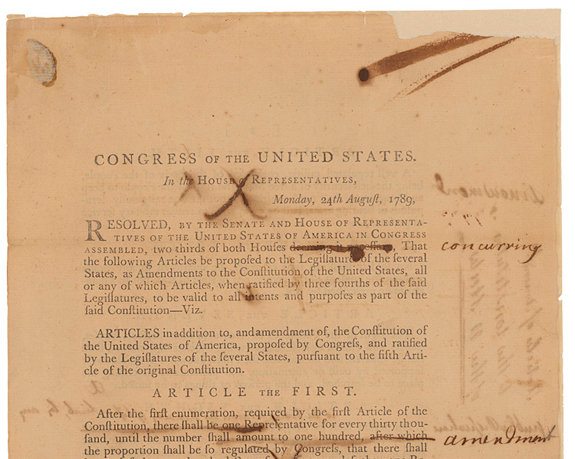There Is No Such Thing As “The” United States Constitution
“There is no unique, tangible, singular, definitive Constitution,” says information scientist Joe Janes

The draft copy of the Bill of Rights, pen-inked revisions and all. Photo: National Archives
The standard image of the writing, and signing, of the US Constitution is one of a bunch of white guys sitting around a big table with fancy pens. But “is there anything in the US Constitution written by women?” asks Joe Janes with the Information Science department at the University of Washington in the third episode of his podcast series Documents that Changed the World.
Probably not, he says, though if you had to guess, your best bet would be the 19th amendment, the ratification of which in 1920 gave women the right to vote. “It’s only 39 words, but powerful words they are. Opening the door to half a nation to fully participate in civic life,” Janes says.
In the podcast, Janes explores the history of the 19th amendment, which he says may, or may not, have been written in part by Susan B. Anthony. Which would make her the first, and perhaps only, woman to have a hand in crafting a constitutional amendment. But, as part of seeking out the role of women in penning the Constitution Janes is drawn into a curious question: Where, physically, is the Constitution? Well, there’s the original version, housed in a big glass case at the National Archives. And as each amendment was added, records from the states and White House have recorded those changes. The archives have a piece of parchment signed by the speaker of the house and the president when the 19th amendment was passed. Other amendments have similar paper trails.
But the version you might see if you were to open a textbook – a copy from beginning to end with all the amendments – doesn’t physically exist. And, Janes says, in reality, it doesn’t really matter where the paper is.
There is no unique, tangible, singular, definitive Constitution. The one you find in a textbook or on a website somewhere, assuming it’s correct, is just as valid, just as useful, just as authentic as one that might sit on the desk of the President, or the Chief Justice.
His point is that the Constitution isn’t a piece of paper. It’s an idea. And while it doesn’t exist, it also exists everywhere. Janes says “Even if we do often passionately disagree about what the words in the Constitution mean, we all agree on what they are, a testament to the power of documents even when you can’t see them.”
More from Smithsonian.com:
George Mason: Forgotten Founder, He Conceived the Bill of Rights - This wise Virginian was a friend to four future presidents, yet he refused to sign the Constitution
/https://tf-cmsv2-smithsonianmag-media.s3.amazonaws.com/accounts/headshot/smartnews-colin-schultz-240.jpg)
/https://tf-cmsv2-smithsonianmag-media.s3.amazonaws.com/accounts/headshot/smartnews-colin-schultz-240.jpg)